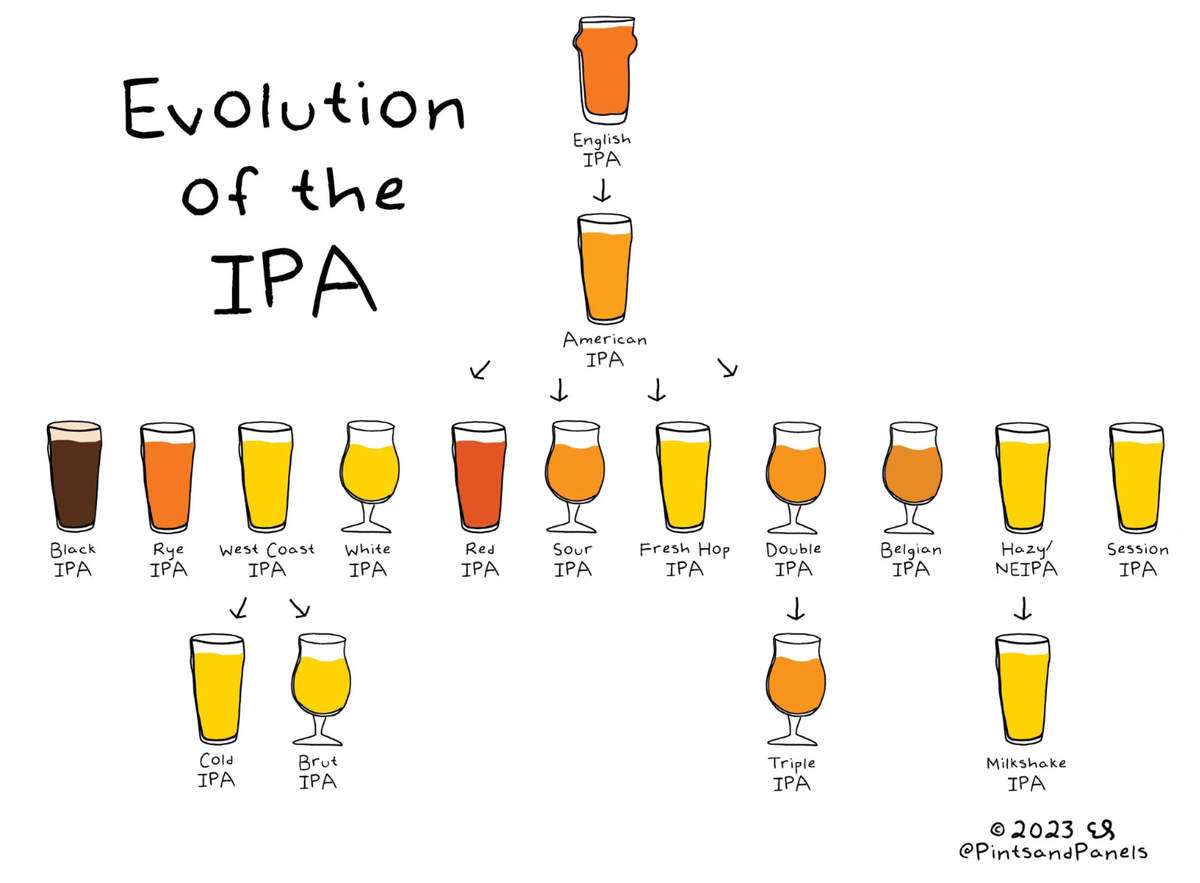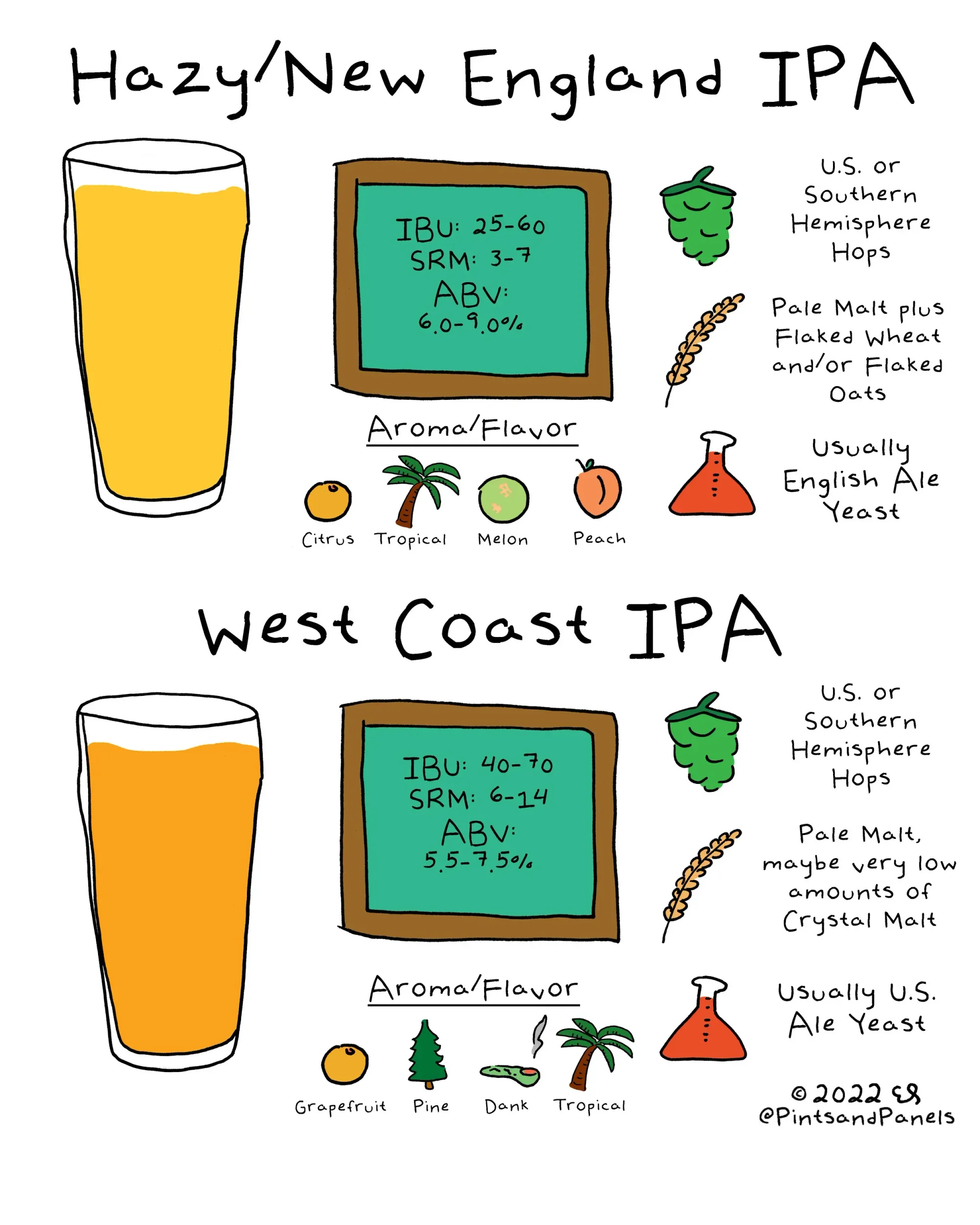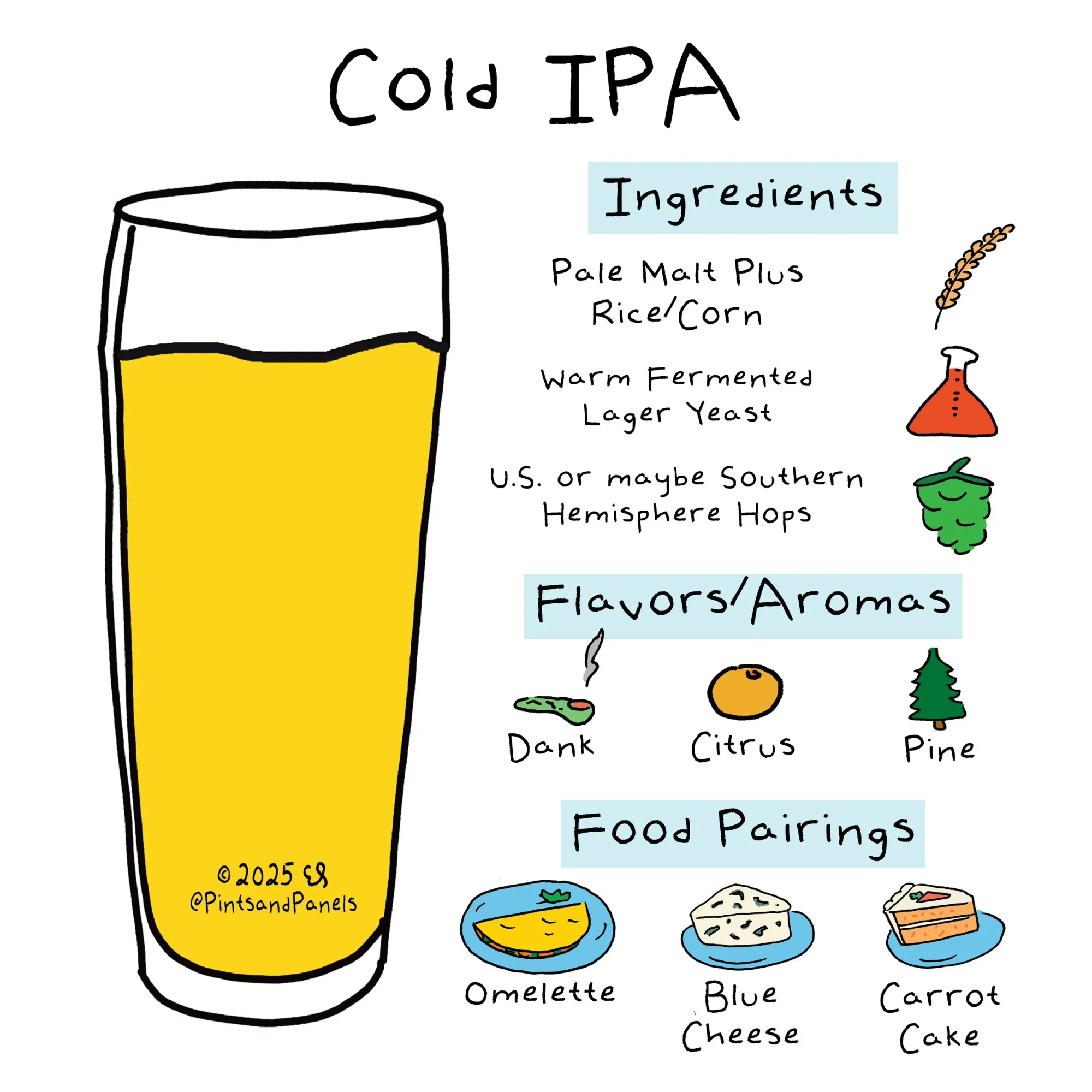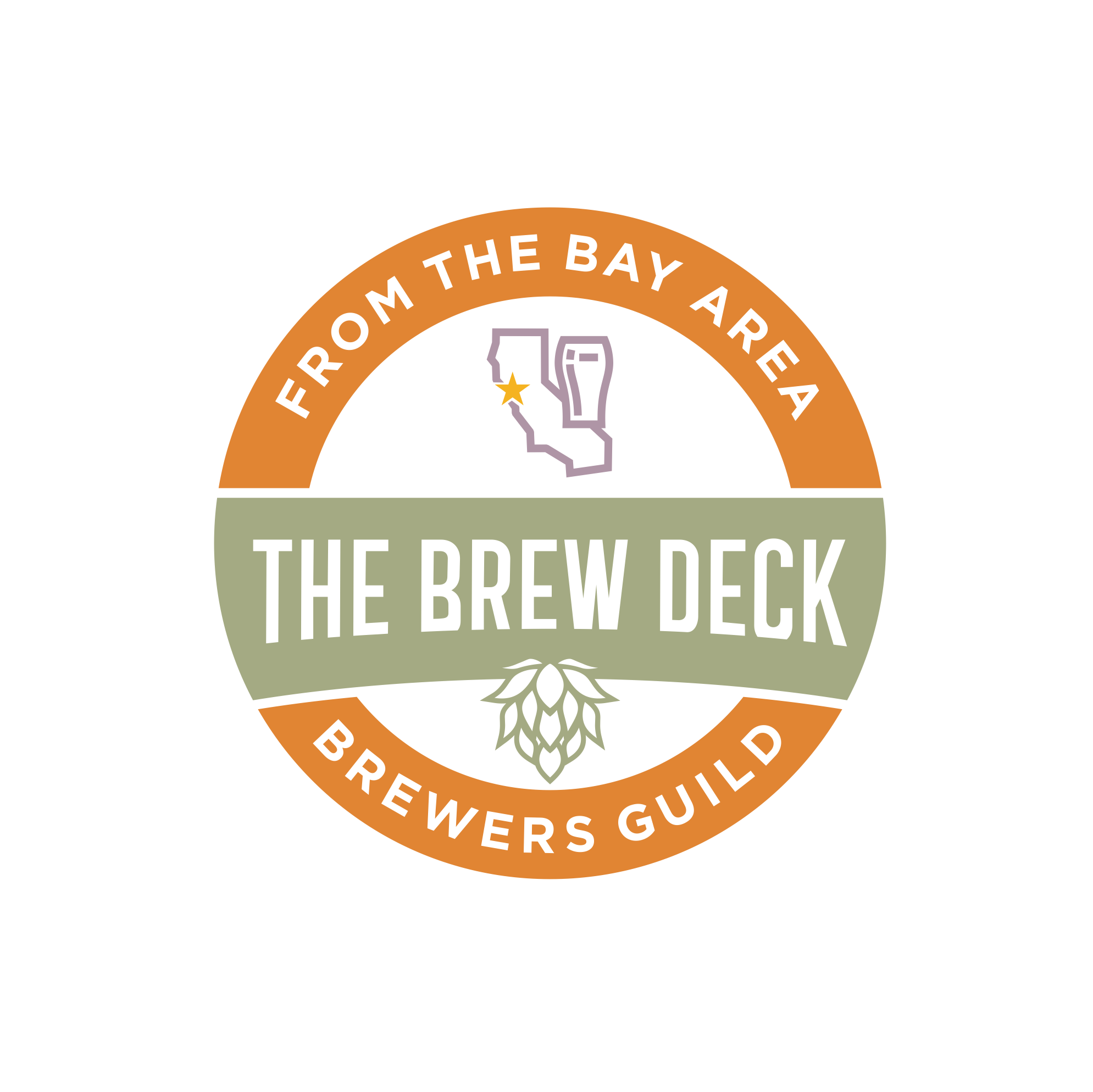Should There Be an IPA for Everyone?

The Endless Evolution of IPA: As American IPA splinters into haze, clarity, cold, and more, one question lingers: how many IPAs does a beer scene really need?
What does a great beer scene entail? A fair answer might be one where as much of the potential spectrum of beer flavor, aroma, color, texture, and strength as possible is available to the consumer in prime condition. Interestingly, however, when considering the world’s most established beer-drinking cultures—places like the United Kingdom, the Czech Republic, Bavaria, and Belgium—we find that mature beer scenes don’t necessarily offer a wide variety of styles. On the contrary, these regions have meticulously refined their brewing techniques and serving practices around a signature set of beers. You won’t be served an excellent Hefeweizen in London or an exemplary Dubbel in Pilsen—that’s not how it works.
Our American IPA Era
Over the past fifteen years, IPAs have become the dominant style in independent American brewing. While it can be difficult to pinpoint the exact percentage, most studies indicate that IPAs of one form or another account for roughly half of all craft beer sold in the U.S.
As IPA’s popularity has grown, so has the acceptable spectrum of what a beer with “IPA” on the label might taste like. When American craft breweries revived the term in the 1980s and ’90s, IPA had a fairly narrow range of characteristics. It was between 6.0 and 7.5% ABV, amber in color, full-bodied, bitter, and smelled of cannabis, caramel, and conifers.
Today, a beer that says “IPA” on the label could be anywhere from 6% to more than 10% ABV. It might be bitter or sweet, crystal clear or completely opaque, and it could smell of anything from gasoline to a watermelon Now and Later. In all its iterations, “IPA” connotes a beer with a strong emphasis on hop aroma. Accordingly, brewers and suppliers throughout the industry are constantly innovating new ingredients and processes to pack more hop expression into these beers.
Two Poles: West Coast and Hazy
While there are numerous variations under the IPA umbrella, the two categories you’re most likely to see on brewery menus are West Coast IPA and Hazy IPA.

Many brewers adhere strictly to style guidelines, but many more plot their IPAs along a graph with a few key axes—clarity, mouthfeel, bitterness, hop varieties, and yeast character. You might encounter a brilliantly clear IPA that tastes juicy, or an opaque ale that’s every bit as bitter as a brewery’s West Coast flagship.
Generally, West Coast IPAs favor higher clarity, neutral fermentation profiles, and aromas that stay tied to the natural world. Hazy IPAs, on the other hand, tend to employ wheat or oats for a softer mouthfeel and use more expressive yeast strains, typically of English derivation. Combine that with newer experimental hop varieties and you end up with aromas that veer toward the synthetic or confectionary—a grapefruit soda or an orange creamsicle—while a West Coast IPA might evoke something closer to the aroma of an actual orange or grapefruit.
The West Coast IPA is the older of these two styles, originating in the 1980s and taking over in the 1990s, led by trailblazing brewers in California, Oregon, and Washington. Hazy IPAs emerged in the 2000s at smaller breweries in the Northeast. It would seem to follow that as the Hazy IPA softened the edges, tamped down bitterness, and highlighted fruit, IPA became more broadly appealing than ever before.
Are Cold IPAs Next?

The expansion of the IPA segment continues today with the so-called “Cold IPA.” Brewmaster Kevin Davey, of the lager-centric Wayfinder Beer in Portland, Oregon coined this term to describe a particular lager-ale hybrid he first brewed in 2022, which was itself in conversation with “Brut IPA,” a style Kim Sturdavant invented in San Francisco just a few years earlier.
Brut IPA took off like a rocket in around 2018 but quickly fizzled. Cold IPA, by contrast, has seen steady growth as more and more brewers pick up on the trend. Like “Brut” before it, Cold IPA takes a very different route to arrive at the same low bitterness, high hop-aroma expression that drew so many to Hazy IPA.
By using lager yeast at warmer temperatures to keep the fermentation clean and snappy, and using adjuncts like rice or corn to lighten the body, Cold IPA creates a crisp canvas for bold hop expression. Where the Hazy IPA smuggled elements of a Bavarian Hefeweizen into the IPA tent—softness, turbidity, expressive yeast—the Cold IPA does the same thing with Pilsner’s austere dryness, ultra-clean fermentation, and brilliant clarity. Cold IPA also points toward the emerging style some brewers are calling “West Coast Pilsner.” More on that in two weeks.
So, Should There Be an IPA for Everyone?
More than any other beer style, contemporary IPA is less fixed tradition than an open invitation, a platform for curiosity and reinvention. So, maybe we won't arrive at a single brew that unites us all, but rather an IPA umbrella that keeps expanding to welcome more of us in.
🍻 Upcoming Events Featuring Our Member Breweries
🎉 Free (Pay-As-You-Go) Public Events This Weekend!
Saturday, 10/11 — Strike Brewing Anniversary Party (San Jose, CA | Noon–10:00 PM)
Raise a pint with San Jose’s hometown brewery as they celebrate another year of great beer.
More Info → 11th Anniversary Celebration
Saturday, 10/11 — 2ND Annual Downtown Pumpkin Patch at Foxtale Fermentation Project (San Jose, CA | Noon–6:00 PM)
Expect an exciting array of pumpkins for the kids to pick from, plus fall food & drink specials from Foxtale’s new fall ferment releases!
More Info → Picking Pumpkins at Foxtale
Saturday, 10/11 — Banned Books and Brews at Clandestine Brewing (San Jose, CA)
In celebration of Banned Books Week, Clandestine Brewing is partnering with the San Jose Public Libraries for a Freedom to Read initiative.
More Info → Clandestine Brewing welcomes the San José Public Library Foundation
Saturday, 10/11 — Socks & Sandals Day at Humble Sea Brewing (Santa Cruz, CA | Noon–5:00 PM)
The annual over-the-top celebration of Socks & Sandals IPA will feature a makers market, delicious food, slushie machines, and the release of several special versions of Humble Sea's flagship ale!
More Info →Socks & Sandals Day In Santa Cruz!
Saturday & Sunday, 10/11–10/12 — Oktoberfest at Pond Farm Brewing (San Rafael, CA)
German food menu, liters and liters of Festbier, Dunkel, Pilsner, Rauchbier, and Altbier, plus stein holding and many other games!
More Info →Oktoberfest in San Rafael
📅 Save the Dates
Saturday, 10/18— Oktoberfest at Canyon Lakes Golf Course & Brewery (San Ramon, CA)
Seasonal beers, authentic German food, live music, and bocce ball at the first championship 18-hole golf course and microbrewery in the country!
More Info →Oktoberfest in San Ramon
Saturday, 10/18 — Sante Adairius Rustic Ales Anniversary Party (Capitola, CA)
Help SARA celebrate thirteen years with DJ 2-Row, tacos, Yakitori, ice cream and some rare beers on tap!
More Info → 13th Anniversary Celebration
Saturday, 10/25— Spooky Puppy at Temescal Brewing (Oakland, CA)
Get ready for the biggest Halloween event of the year, a puptacular event filled with delicious beer and adorable pups, SPOOKY PUPPY 2025!
More Info →Spooky Puppy Pageant & Costume Contest In Oakland
Friday 2/20/2026 - Sunday 3/1/2026 — Beer Week 2026 (The Whole Damn Bay Area!)
The biggest and best regional celebration of independent craft beer on the planet!
Keep up-to-date on all the events at sfbeerweek.org
